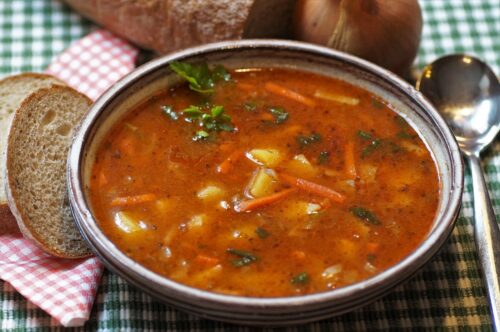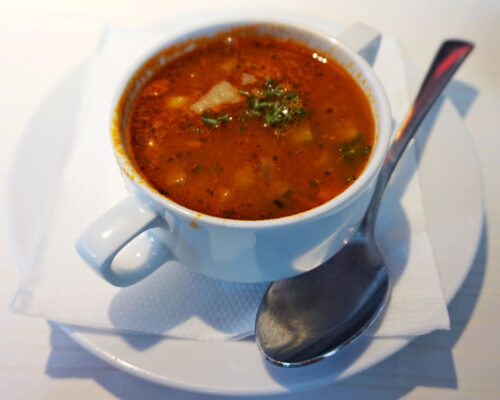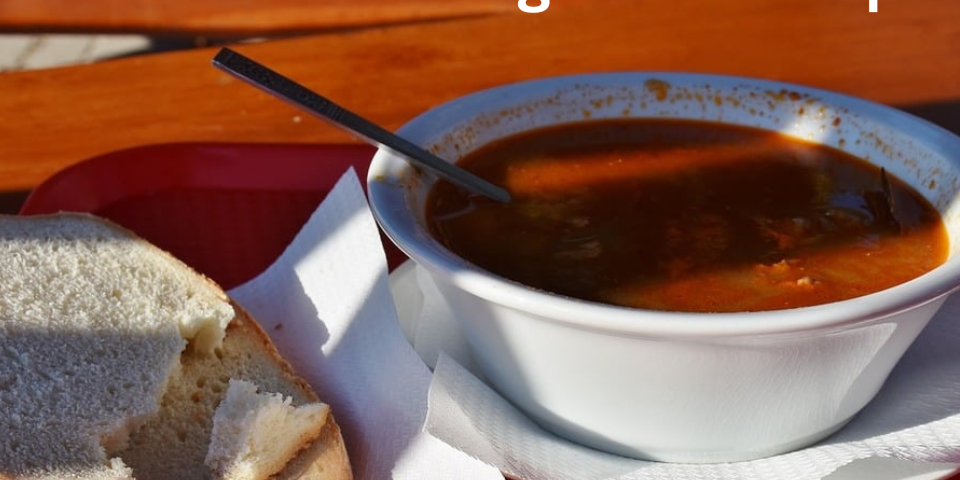
Simple korean hotteok recipe
June 5, 2024
Mary Berry’s cauliflower soup
June 16, 2024What to eat with goulash soup
Wondering what to eat with goulash soup? Try pairing it with crusty bread, mashed potatoes, or egg noodles. For a fresh and tangy side, consider cucumber salad or pickled vegetables. These sides are perfect choices for what to eat with goulash soup and make it even more satisfying.
Goulash pairs well with a variety of side dishes:
- Crusty Bread: Great for soaking up the tasty broth.
- Mashed Potatoes: Creamy and smooth, perfect with the hearty stew.
- Egg Noodles or Spaetzle: These soak up the goulash flavors well.
- Pickled Vegetables: Provide a refreshing, tangy contrast.
- Cucumber Salad: Light and crisp, balancing the richness of the goulash.
- Roasted Vegetables: Add a sweet, caramelized flavor that pairs well with the savory stew.
What is Goulash?
Goulash is a traditional Hungarian dish known for its rich taste and, hearty flavors. It typically consists of tender beef chunks, onions, and a generous amount of paprika, with vegetables like bell peppers, tomatoes, and potatoes often included. Goulash can be enjoyed as a soup or a stew, and there are many different versions across Central and Eastern Europe.
History of Goulash Soup:
Let’s explore its origins:
Origins in Hungary:
- Goulash, known as gulyas in Hungarian, originated in Hungary. Goulash has since become a symbol of Hungarian cuisine, loved by many across Central and Eastern Europe
- The dish’s roots can be traced as far back as the 10th century when Hungarian shepherds prepared stews while tending their herds. These early versions of goulash were simple and practical meals.
- The cooked and flavored meat was dried using sunlight and packed into bags made from sheep’s stomachs. To turn it into a meal, they only needed water.
- Interestingly, the original goulash did not include paprika, as this spice was not introduced to Europe until the 16th century.
Etymology:
- The name “goulash” comes from the Hungarian word “gulyas”, which means “herdsman” or “cowboy”.
- Initially, “gulyas” referred only to the herdsman, but over time, it also came to represent the stew they prepared.
- In medieval times, Hungarian herders used every part of the animal, making the most of scarce meat. Their stew was hearty and sustained them during long journeys on the plains.
Ingredients and Preparation:
- Traditional Hungarian goulash was made by cattle herders and stockmen. They cooked over open fires in large cauldrons, using simple, nonperishable supplies like millet, lard, bacon, onions, salt, and sometimes black pepper.
- If a cow died or was slaughtered, the herders would feast on a rare dish of fresh meat. They browned the meat in lard and onions, adding water and, if available, black pepper.
- Over time, they began substituting coarsely ground dried red chilies (from home gardens) for black pepper.
- By the end of the 18th century, travelers encountered this rough, spicy peasant dish that left a pleasant warmth in the stomach.
- Since the term for herdsmen was “gulyas,” the dish became known as “gulyas hus” (herdsmen’s meat), eventually shortened to “goulash”.
Paprika’s Role:
- The introduction of refined varieties of paprika from ground red chilies transformed goulash into an international staple.
- By the end of the 19th century, Hungarians had bred new chili varieties, processed them, and created their defining spice: paprika.
- Paprika became an essential flavoring in goulash, sprinkled on bread, lard, cheese, and salami, and used abundantly in the stew.
Key Ingredients in Goulash
- Beef Chunks: The star of the show, providing a hearty base.
- Onions: Adds sweetness and depth.
- Paprika: Gives the dish its signature color and spice.
- Vegetables: Bell peppers, tomatoes, and potatoes are commonly included for added flavor and texture.
Health Benefits of Goulash Ingredients
- Beef: High in protein and iron.
- Vegetables: Packed with vitamins and fiber.
- Paprika: Contains antioxidants and vitamins A and E.

How is Goulash Prepared?
To prepare goulash, follow these essential steps:
- Saute Onions and Garlic: Begin by cooking chopped onions in oil or lard until they are golden brown. Add minced garlic on a light flame.
- Brown the Meat: Add chunks of beef (or other meat) and brown them on all sides.
- Incorporate Spices: Remove the pot from heat and stir in sweet Hungarian paprika, and optionally, hot paprika for extra heat. This prevents the paprika from burning.
- Simmer the Ingredients: Add broth, tomatoes, and additional vegetables like bell peppers and potatoes. Season with salt, pepper, caraway seeds, and bay leaves.
- Cook Slowly: Let the mixture simmer on low heat until the meat and vegetables are tender, which typically takes 1.5 to 2 hours.
- Final Adjustments: Adjust the seasoning to taste, and optionally, add a splash of vinegar or lemon juice for a slight tang.
How Much Time is Required to Make Goulash?
The time required to make goulash depends on the specific recipe and whether it is prepared as a soup or a stew. Normally, it takes about 2 to 2.5 hours:
- Preparation Time: 20-30 minutes for chopping and initial sautéing.
- Cooking Time: 1.5 to 2 hours of simmering to achieve tender meat and well-blended flavors.
What to eat with goulash soup: A detailed description:
Here is a detailed description of each side dish to complement your goulash soup:
Bread
-
Crusty Bread:
- Description: Rustic breads like baguette, ciabatta, or sourdough have a crunchy exterior and a soft, airy interior.
- How to Serve: Slice the bread and serve in a basket. Optionally, warm it in the oven before serving to enhance its aroma and texture.
- Why It Works: The crusty texture is perfect for dipping into the goulash soup, soaking up the rich broth and enhancing each bite.
-
Garlic Bread:
- Description: Slices of bread, usually baguette or Italian bread, slathered with a mixture of butter, garlic, and parsley, then toasted until golden.
- How to Serve: Serve hot, straight from the oven, so the butter is still melted and the bread is crisp.
- Why It Works: The garlic flavor complements the spices in the goulash, while the crispy texture provides a pleasant contrast.
-
Rye Bread:
-
- Description: A dense, slightly tangy bread made from rye flour, often with caraway seeds.
- How to Serve: Slice thinly and serve at room temperature or lightly toasted.
- Why It Works: The earthy, slightly sour taste of rye bread pairs well with the robust flavors of goulash.
Potatoes
-
Mashed Potatoes:
- Description: Creamy, fluffy potatoes mashed with butter, milk, and a touch of salt.
- How to Serve: Serve hot, in a bowl, with a pat of butter melting on top.
- Why It Works: The creaminess of mashed potatoes balances the spiciness and richness of the goulash soup.
-
Roasted Potatoes:
- Description: mall potatoes roasted with olive oil, salt, pepper, and herbs until crispy.
- How to Serve: Serve hot with a sprinkle of fresh herbs like rosemary or parsley.
- Why It Works: The crispy exterior and tender interior of roasted potatoes add a delightful texture contrast to the soup.
-
Potato Pancakes (Latkes):
- Description: Grated potatoes mixed with onions, eggs, and flour, then fried until crispy.
- How to Serve: Serve hot with a side of applesauce or sour cream.
- Why It Works: The crispy, savory pancakes complement the hearty goulash and add an extra element of flavor.
Noodles and Dumplings
-
Egg Noodles:
- Description: Egg noodles are wide noodles made from eggs and flour. They’re cooked until tender.
- How to Serve: Serve them warm, and you can toss them with a bit of butter or olive oil to keep them from sticking together.
- Why It Works: The soft, slightly chewy texture of egg noodles is perfect for soaking up the flavorful broth of the goulash.
-
Spaetzle:
- Description: Small, soft dumplings made from a batter of flour, eggs, and milk, boiled and then sometimes sautéed in butter.
- How to Serve: Serve warm, possibly with a sprinkle of fresh parsley.
- Why It Works: Spaetzle’s light, airy texture is perfect for absorbing the goulash’s flavors, adding a comforting touch to the meal.
-
Dumplings:
- Description: Hearty bread or potato dumplings, often made with stale bread, milk, eggs, and herbs, boiled until tender.
- How to Serve: Serve warm, sliced or whole, with a drizzle of melted butter or gravy.
- Why It Works: These dumplings are perfect for soaking up the goulash soup, adding both texture and flavor.
Vegetables
-
Pickled Vegetables:
- Description: Vegetables such as cucumbers, carrots, or peppers preserved in a vinegar-based brine.
- How to Serve: Serve cold or at room temperature, in small bowls or on a platter.
- Why It Works: The tanginess and crunch of pickled vegetables provide a refreshing contrast to the rich and spicy goulash.
-
Steamed Vegetables:
- Description: Lightly steamed vegetables like carrots, green beans, or peas, often seasoned with a bit of salt and butter.
- How to Serve: Serve hot, lightly seasoned, in a serving bowl.
- Why It Works: The simple, fresh flavors of steamed vegetables balance the heavy, rich soup, offering a healthy side option.
-
Roasted Root Vegetables:
- Description: Root vegetables like carrots, parsnips, and beets, roasted with olive oil, salt, pepper, and herbs.
- How to Serve: Serve hot, straight from the oven, with a sprinkle of fresh herbs.
- Why It Works: The natural sweetness and caramelization of roasted root vegetables complement the savory flavors of the goulash.
Salads
-
Cucumber Salad:
- Description: Thinly sliced cucumbers tossed with vinegar, a bit of sugar, salt, and fresh dill.
- How to Serve: Serve cold, in a bowl, garnished with extra dill.
- Why It Works: The refreshing, tangy flavor of cucumber salad is a great palate cleanser alongside the rich goulash.
-
Mixed Green Salad:
- Description: A mix of fresh greens like lettuce, spinach, and arugula, with a light vinaigrette.
- How to Serve: Serve chilled, in a bowl, with the dressing on the side or lightly tossed.
- Why It Works: The crisp, fresh greens and light dressing balance the hearty and rich goulash.
-
Tomato and Onion Salad:
- Description: Sliced tomatoes and onions, drizzled with olive oil and vinegar, and seasoned with salt and pepper.
- How to Serve: Serve at room temperature, in a shallow dish, garnished with basil or parsley.
- Why It Works: The juicy, acidic tomatoes and sharp onions cut through the richness of the goulash.
Dairy
-
Sour Cream:
- Description: A thick, tangy dairy product often used as a condiment.
- How to Serve: Serve in a small bowl with a spoon, allowing guests to add a dollop to their soup.
- Why It Works: Sour cream adds a cool, creamy contrast to the spicy and rich goulash, enhancing its flavors.
-
Cheese:
- Description: A side of cheese such as sharp cheddar, gouda, or feta.
- How to Serve: Serve sliced or in chunks, on a cheese board with bread or crackers.
- Why It Works: Cheese adds an extra layer of richness and a variety of textures that complement the goulash.
These side dishes, with their varied textures and flavors, will enhance your goulash soup, making for a delicious and satisfying meal.
Traditional Hungarian Goulash Soup Recipe
Ingredients:
- 2 tablespoons vegetable oil or lard
- 2 large onions, finely chopped
- 2 cloves garlic, minced
- 1.5 lbs (700g) beef chuck or shin, cut into 1-inch cubes
- 2 tablespoons sweet Hungarian paprika
- 1 teaspoon hot Hungarian paprika (optional, for heat)
- 1 teaspoon caraway seeds, crushed
- 1 large tomato, peeled and chopped, or 1 tablespoon tomato paste
- 2 large bell peppers, chopped (preferably red and green)
- 3 large carrots, sliced
- 2 large potatoes, peeled and cubed
- 1 parsnip or 1 small celery root, peeled and cubed (optional)
- 6 cups beef broth or water
- Salt and pepper to taste
- 1 bay leaf
- 1 tablespoon vinegar or juice of half a lemon (optional, for a slight tang)
- Fresh parsley, chopped, for garnish
Instructions:
- Heat the Oil: In a large pot or Dutch oven, heat the oil or lard over medium heat. Add the onions and cook until they are soft and golden brown, about 8-10 minutes.
- Add the Garlic and Beef: Add the minced garlic and cook for another minute until fragrant. Add the beef cubes and cook, stirring frequently, until the meat is browned on all sides.
- Season with Paprika and Caraway Seeds: Remove the pot from heat and stir in the sweet paprika, hot paprika (if using), and crushed caraway seeds. This step is crucial to prevent the paprika from burning and becoming bitter.
- Add Tomatoes and Peppers: Stir in the chopped tomatoes (or tomato paste) and bell peppers. Put the pot back on the heat and cook for a few minutes until the peppers begin to soften.
- Simmer the Soup: Pour in the beef broth or water, add the bay leaf, and bring to a boil. Reduce the heat to low and let the soup simmer, covered, for about 1.5 to 2 hours, or until the beef is tender.
- Add the Vegetables: Add the sliced carrots, cubed potatoes, and parsnip or celery root (if using). Continue to simmer for another 30 minutes, or until the vegetables are tender.
- Season and Adjust: Season the soup with salt and pepper to taste. If desired, add the vinegar or lemon juice for a slight tangy flavor.
- Serve: Ladle the hot goulash soup into bowls, garnish with chopped fresh parsley, and serve with crusty bread or your preferred side.
Tips:
- Meat Choice: Beef chuck or shin is ideal because it becomes tender and flavorful when slow-cooked.
- Paprika Quality: Use high-quality Hungarian paprika for the best flavor.
- Simmering Time: Slow cooking allows the flavors to meld and the beef to become tender.
Enjoy your traditional Hungarian goulash soup, a hearty and comforting dish perfect for any
what are different types of goulash soups?
Goulash soup, a traditional dish with roots in Hungarian cuisine, has various regional and stylistic variations. Here are some different types of goulash soups:

1. Hungarian Goulash (Gulyásleves)
- Description: The classic and most well-known type of goulash soup. It features beef, onions, paprika, tomatoes, and potatoes.
- Key Ingredients: Beef, onions, sweet paprika, tomatoes, bell peppers, potatoes, garlic, caraway seeds, and beef broth.
- Characteristics: A rich and hearty soup with a distinctive red color from the paprika, usually served with fresh bread.
2. Austrian Goulash (Wiener Saftgulasch)
- Description: A variation from Austria that is usually thicker and more stew-like.
- Key Ingredients: Beef, onions, paprika, marjoram, caraway seeds, and garlic.
- Characteristics: Often served with bread dumplings or spaetzle, this version emphasizes a longer cooking time for a richer flavor.
3. German Goulash (Gulaschsuppe)
- Description: Similar to the Hungarian version but often includes additional ingredients like carrots and celery.
- Key Ingredients: Beef, onions, carrots, celery, potatoes, paprika, marjoram, and caraway seeds.
- Characteristics: A slightly milder flavor, often served as a hearty winter soup.
4. Czech Goulash (Guláš)
- Description: A popular variation in the Czech Republic, usually thicker and served as a main dish.
- Key Ingredients: Beef, onions, paprika, marjoram, garlic, caraway seeds, and flour to thicken.
- Characteristics: Often served with bread dumplings (knedlíky) or boiled potatoes.
5Slovak Goulash (Gulášová polievka):
- Description: This is a soup version of goulash from Slovakia. It’s known for being spicier than other versions and is often enjoyed with bread.
- Key Ingredients: The main ingredients include beef, onions, potatoes, paprika, garlic, caraway seeds, and sometimes sauerkraut.
- Characteristics: Slovak goulash is famous for its bold flavors. It’s sometimes served with a dollop of sour cream for extra richness.
6. Croatian Goulash (Gulaš)
- Description: A Mediterranean twist on the classic goulash, often featuring red wine.
- Key Ingredients: Beef, onions, garlic, paprika, tomatoes, red wine, and bay leaves.
- Characteristics: A rich and flavorful soup, sometimes served with pasta or polenta.
7. Romanian Goulash (Gulaș)
- Description: A variation that might include pork or veal and often incorporates vegetables like bell peppers.
- Key Ingredients: Pork or veal, onions, paprika, bell peppers, tomatoes, and garlic.
- Characteristics: A thick, stew-like consistency with a robust flavor profile.
8. Polish Goulash (Gulasz)
- Description: Similar to Hungarian goulash but often includes mushrooms and sometimes pickles.
- Key Ingredients: Beef or pork, onions, mushrooms, paprika, tomatoes, and sometimes pickles.
- Characteristics: A hearty and slightly tangy flavor, typically served with potatoes or bread.
9. Italian Goulash (Gulasch all’Italiana)
- Description: An Italian adaptation that might include wine and Italian herbs.
- Key Ingredients: Beef, onions, paprika, tomatoes, red wine, garlic, and rosemary.
- Characteristics: A fusion of Hungarian and Italian flavors, often served with polenta or pasta.
10. American Goulash
- Description: A distinctly different dish, often more like a pasta-based casserole.
- Key Ingredients: Ground beef, macaroni, tomatoes, onions, and paprika.
- Characteristics: A comfort food classic in the United States, typically not a soup but a one-pot pasta dish.
Each of these goulash soups has its unique ingredients and preparation methods, reflecting the culinary traditions and local flavors of the regions they come from.
Conclusion:
In summary, goulash soup is a comforting and flavorful dish loved for its tender beef, aromatic spices, and hearty vegetables. Whether you follow a traditional recipe or a simplified version, the slow simmering process enhances the flavors, creating a satisfying meal. Wondering what to eat with goulash soup? Try pairing it with crusty bread, mashed potatoes, or egg noodles. For a fresh and tangy side, consider cucumber salad or pickled vegetables. These sides complement the soup perfectly, making it even more delicious and satisfying.

FAQ
What food goes well with goulash?
Crusty bread, garlic bread, rye bread, mashed potatoes, roasted potatoes, potato pancakes, egg noodles, spaetzle, pickled vegetables, steamed vegetables, roasted root vegetables, cucumber salad, mixed green salad, and tomato and onion salad.
What is the traditional accompaniment to goulash?
Crusty bread or rye bread is the traditional accompaniment, perfect for soaking up the rich broth.
What starter to serve with goulash?
A light starter such as a cucumber salad, mixed green salad, or tomato and onion salad works well to balance the richness of the goulash.
Is goulash a stew or a soup?
Goulash can be both; traditional Hungarian goulash is a soup, while variations like Austrian and Czech goulash can be thicker and more stew-like.
What is true goulash made of?
True Hungarian goulash is made of beef, onions, sweet paprika, tomatoes, bell peppers, potatoes, garlic, caraway seeds, and beef broth.
can you serve goulash with rice?
Yes, you can serve goulash with rice. The rice will absorb the rich flavors of the goulash, making for a satisfying and hearty meal.
What food goes well with goulash?
Goulash pairs well with side dishes like polenta, mashed potatoes, and crusty bread. These complement the rich flavors of the stew.
What is the traditional accompaniment to goulash?
The traditional accompaniment to goulash includes dumplings, bread, or noodles. These absorb the flavorful sauce.
What starter to serve with goulash?
For a starter, consider a cucumber salad or a light vegetable appetizer to balance the meal.
Is goulash a stew or a soup?
Goulash is traditionally a stew, but there’s also a soup-like version with a rich broth.
What is true goulash made of?
True goulash features chunks of meat (often beef), onions, and paprika. Authentic Hungarian goulash is not made with ground beef or macaroni noodles.


